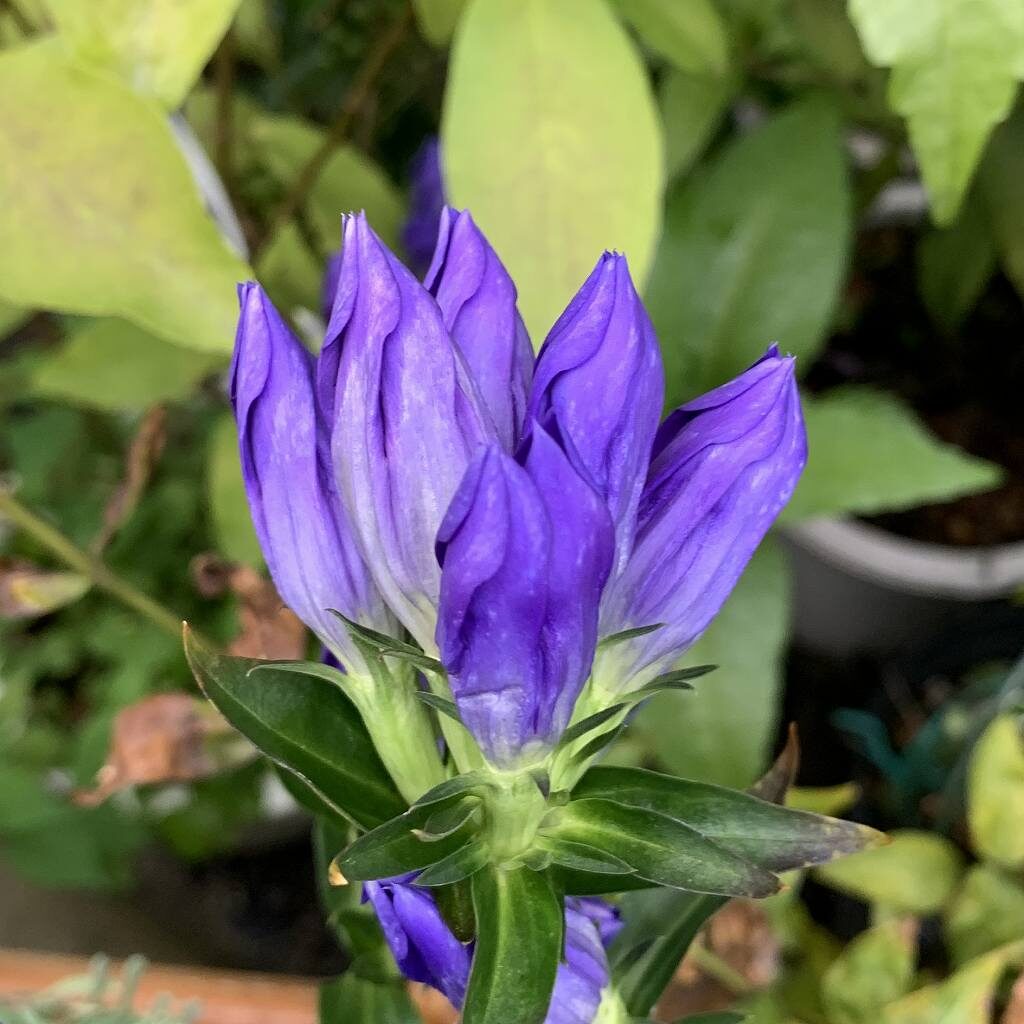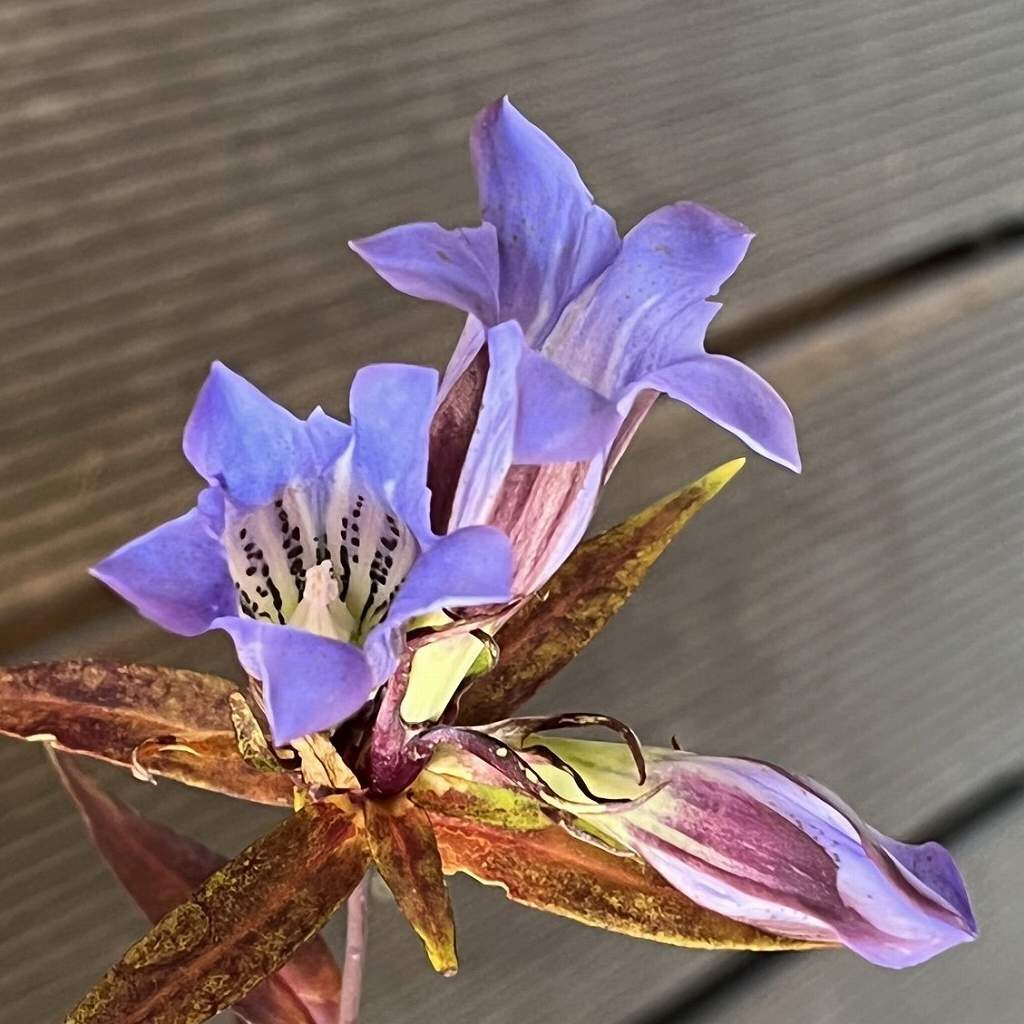リンドウは、古くから知られる日本在来の薬用植物で日当たりの良い山野に自生。花は筒状の釣鐘形で、陽がさすと開き、かげると閉じます。
Japanese Gentian has long been known as a medicinal plant in Japan, and grows wild in sunny mountains and fields. The flowers are tubular, bell-shaped, and open when the sun shines and close when the sun gets dark.
【仮名】リンドウ, ササリンドウ
【和名】竜胆, 笹竜胆
【英名】Japanese Gentian
【学名】Gentiana scabra
【誕生】09/ 16, 10/ 01, 10/ 20
【開花】09, 10, 11月
【花色】White, Pink, Violet, Blue



リンドウ
リンドウの生態
リンドウはリンドウ科の多年草です。日本では関東以西の本州、四国、九州、国外では朝鮮半島、中国に分布。日当たりの良い山野に自生し、花は陽がさすと開き、かげると閉じます。リンドウ属の総称でもあるので、区別するために「笹竜胆」とも。古くから知られる薬用植物です。
リンドウの名前
リンドウの名前は漢名の「龍膽」に由来し、その音読み「リュウタン」が転訛したものです。漢名は、その根が熊の胆嚢よりも苦いことに由来し、架空の生物「竜」の胆嚢に喩えられたため。その苦味が薬に用いられたので「疫病草」「胃病み草」「けろり草」などの別名もあります。
リンドウの姿形
リンドウの根は黄白色で細く、分枝しながら地中深くまで伸長。葉は柄がなく、茎を抱いて対生し、先の尖った披針形で、表面がザラつきます。花は筒状の釣鐘形で花冠が5裂、雄しべが5本、雌しべの柱頭が2裂。花後の蒴果は熟すと裂け、翼のついた種子を風に乗せて散らします。
リンドウの近縁
リンドウの近縁種「蝦夷竜胆」は草丈も花も大きく、北海道から本州の近畿地方まで分布。「御山竜胆」は花が小さく、陽がさしても開かず、本州の中部地方以北の山地に生えます。これら2種が「リンドウ」の園芸名で流通。一方、変種「細葉竜胆」は葉が細長く、湿地に生えます。
リンドウの利用
リンドウの根は生薬「竜胆」として漢方に。飲用により、ゲンチオピクリンやゲンチアニンなどの苦味成分が味覚を刺激し、唾液や胃液の分泌を促します。調製は茎葉が枯れる晩秋~初冬に、根を切らないよう掘り上げ、水で洗って天日乾燥。食欲不振や消化不良などに用いられます。
Japanese Gentian
Japanese Gentian is a perennial herb of Gentianaceae. In Japan, it is distributed in Honshu, Shikoku, and Kyushu west of the Kanto region, and in the Korean Peninsula and China outside of Japan. It grows naturally in sunny mountains and fields, and the flowers open when the sun shines and close when the sun gets dark. It is also a generic name for the Gentian genus, so “Bamboo like” is sometimes added to distinguish it in Japanese. It is a medicinal plant that has been known since ancient times.
The Japanese name of Japanese Gentian comes from the Chinese name “Dragon Gallbladder”. Its Chinese name was likened to the mythical creature “dragon” because its roots are bitterer than a bear’s gallbladder. Since its bitter taste was used as a medicine, it is also known as “Plague grass”, “Stomach sickness grass”, and “Healing grass.”
Japanese Gentian roots are yellowish white and slender, and extend deep into the ground while branching. The leaves are stalkless, opposite, lanceolate with pointed tips, and rough on the surface. The flowers are tubular, bell-shaped, with 5-lobed corollas, 5 stamens, and 2-lobed pistils. The post-flowering capsule splits when ripe and scatters the winged seeds on the wind.
Relative of Japanese Gentian, “Gentiana triflora” has large plant height and flowers, and is distributed from Hokkaido to the Kinki region of Honshu. “Gentiana makinoi” has small flowers not opening even when the sun shines, and grows in the mountains north of the Chubu region of Honshu. These two species are in circulation under the horticultural name “Gentian”. On the other hand, the variety “stenophylla” has elongated leaves and grows in wetlands.
The root of Japanese Gentian is used in Chinese medicine as a herbal medicine. When consumed, bitter ingredients such as gentiopicrine and gentianine stimulate the sense of taste and promote the secretion of saliva and gastric juice. It is prepared in late autumn to early winter when the foliage dies, digging up without cutting the roots, washing with water and drying in the sun. It is used for anorexia and indigestion.


